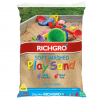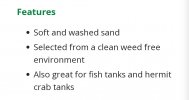fyrefish
Member
- Messages
- 54
Hey, I'm getting a new tank soon and have been looking around for products to scape it with. I was going to use natural sand, when I saw just how expensive 'aquarium sand' is. However, I have heard before that plain old play sand is perfectly fine for aquariums, you just have to rinse it well. There are nearby hardware stores selling it for just $8 AUD for 20kg, which is a lot cheaper than 'aquarium sand'. Is this safe for apistogramma, and will plants do ok in it? Only really planning on having val or crypts in the substrate, other plants will be epiphytes. I have attached a pic of the specific play sand they are selling.

